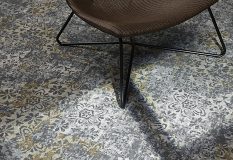Blog
Unlocking Bodmin Jail’s past and releasing a brighter future

Sitting on the edge of Bodmin Moor in Cornwall is Bodmin Jail. An impressive, imposing building originally built during the reign of King George III in 1779 by Napoleonic prisoners of war. Of course, it’s no longer a jail but has recently been transformed into a luxurious hotel and visitor attraction.
Newhey are proud to have been involved in the transformation of this once gloomy and dilapidated building by designing and manufacturing bespoke carpets for guestrooms and public areas throughout this hotel, which is steeped in history, mystery and intrigue.

Famed for its harsh punishments, the jail has a history of imprisonment for minor misdemeanours such as stealing milk from a cow or breaking into the local shop as well as housing the worst criminals who have committed crimes such as rape and murder.
Built by Sir John Call, a military engineer, construction started in early 1770s and used 20,000 tonnes of local Delank granite and stone which came from a nearby quarry. The prison was first built as part of the ground-breaking Prison Reform which was initiated by John Howard who, during his lifetime, conducted an extensive tour and study of prisons in Britain and on the continent.
In 1774 he presented his evidence to the House of Commons committee which led to two Acts aimed to improve conditions in jails. His findings were read by many and his detailed accounts of inhumane conditions were cause for concern.
In a bid to change the system, John worked towards reforming and rehabilitating prisoners by introducing a regime of solitary confinement, hard labour and religious instruction. His creation of state-controlled prisons saw the introduction of tougher regimes but also a healthier environment. Bodmin Jail saw the vision of what prisons were to become in the future, introducing individual cells, segregated male and female areas and hot water. Rumour has it that prisoners were allowed one tepid bath every three months – eww!

Punishments for the prisoners were pretty horrific, there was a treadmill, aka the treadwheel or ‘everlasting staircase’, which prisoners would walk on to create power for the jail’s corn mill. Prisoners would take turns – 15 minutes on the treadmill and 15 minutes picking apart old rope – for a total of 8 hours a day, 6 days a week. So next time you’re on the treadmill at the gym, thank your lucky stars you’re not in an 18th Century prison.
Prison numbers were relatively low until 1820, however, overcrowding due to the increase in jail sentences for petty crimes meant multiple prisoners occupied a single cell. This led to the prison being extended several times through to 1850.

Between 1856-1861, under the reign of Queen Victoria, the original buildings were demolished and a new 220 cell prison was built on the same site. Until 1869 the prison was mainly used as a debtor’s prison until imprisonment for that particular crime was abolished.
From 1887 parts of the prison were used by the Royal Navy and, in 1911, the women’s prison was closed with remaining inmates transferred to Plymouth. Finally, the entire prison closed in 1922.
At some point in the 1930s and 40s there were numerous attempts to blow up the prison to deconstruct it for salvage, however, it was unsuccessful due to the walls being over one metre thick.
Now here’s an interesting fact, during World War I, the prison was used for holding some of Britain’s national treasures including the Domesday Book and the Crown Jewels.


Fast forward 80 years to 2004 when a local family purchased the old building and started the laborious process of restoring the crumbling and delipidated walls, turning parts of the historical building into a tourist attraction.
The last chapter of Bodmin Jail’s story (so far), started in 2015 when a local businessman brought his family on holiday to area. During their visit to the attraction, he fell in love with the heritage and stories behind the dark and gloomy walls. Over the past 6 years the attraction has undergone a £30m development transforming the building into a 63-bedroom hotel within the two original prison wings, and a new £8.5m visitor attraction and education centre.

Newhey Carpets manufactured over 3,700 square metres of 80/20 bespoke colortec carpet for the guestrooms and public areas throughout this hotel. Twelve Architects were leading the consultant team for the alteration, extension and change of use of the Grade II listed building.
Twelve Architects have done a magnificent job with the restoration of this historic structure which is now a leading visitor attraction, venue, hotel and teaching facility for local schools and universities that gives back to Bodmin, Cornwall and the UK. The building’s original features have been retained as much as possible without removing the unique atmosphere and history which still oozes from every nook and cranny.

The cell blocks of the jail have been transformed into the guestrooms, retaining the rich colours and texture of the original stonework and a glazed roof to the atrium captures the natural lighting which was present when the building was in ruins.
If sleeping in a spooky hotel room isn’t enough, the museum will bring some of the grimmest stories to life with state-of-the-art theatrical effects. With a ‘Dark Walk’ experience to raise the blood pressure, a lie down may be needed after a spine-tingling day walking the chilly corridors learning about the grisly tales of Bodmin Jail.


 Stock Collections
Stock Collections Express Collection
Express Collection Bespoke Design Service
Bespoke Design Service Area Rugs
Area Rugs Heritage
Heritage Local Supply
Local Supply News
News Meet our Team
Meet our Team